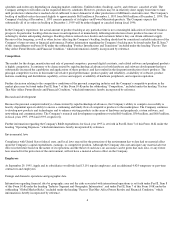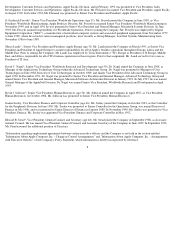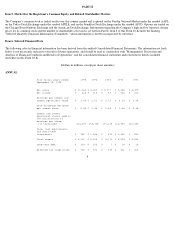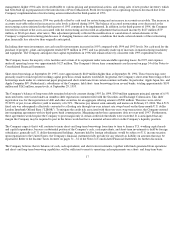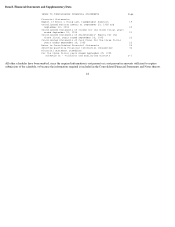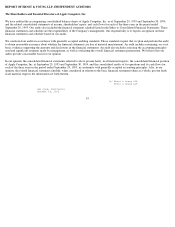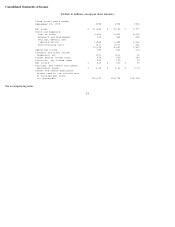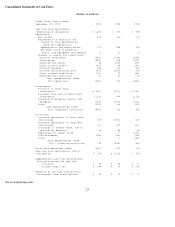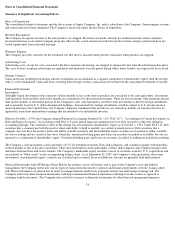Apple 1995 Annual Report Download - page 17
Download and view the complete annual report
Please find page 17 of the 1995 Apple annual report below. You can navigate through the pages in the report by either clicking on the pages listed below, or by using the keyword search tool below to find specific information within the annual report.Global Market Risks
A large portion of the Company's revenue is derived from its international operations. As a result, the Company's operations and financial
results could be significantly affected by international factors, such as changes in foreign currency exchange rates or weak economic conditions
in the foreign markets in which the Company distributes its products. When the U.S. dollar strengthens against other currencies, the U.S. dollar
value of non-U.S. dollar-based sales decreases. When the U.S. dollar weakens, the U.S. dollar value of non- U.S. dollar-based sales increases.
Correspondingly, the U.S. dollar value of non-U.S. dollar-based costs increases when the U.S. dollar weakens and decreases when the U.S.
dollar strengthens. Overall, the Company is a net receiver of currencies other than the U.S. dollar and, as such, benefits from a weaker dollar
and is adversely affected by a stronger dollar relative to major currencies worldwide. Accordingly, changes in exchange rates, and in particular
a strengthening of the U.S. dollar, may negatively affect the Company's consolidated sales and gross margins (as expressed in U.S. dollars).
To mitigate the short-term impact of fluctuating currency exchange rates on the Company's non-U.S. dollar-based sales, product procurement,
and operating expenses, the Company regularly hedges its non-U.S. dollar- based exposures. Specifically, the Company enters into foreign
exchange forward and option contracts to hedge firmly committed transactions. Currently, hedges of firmly committed transactions do not
extend beyond one year. The Company also purchases foreign exchange option contracts to hedge certain other probable, but not firmly
committed transactions. Hedges of probable, but not firmly committed transactions currently do not extend beyond one year. To reduce the
costs associated with these ongoing foreign exchange hedging programs, the Company also regularly sells foreign exchange option contracts
and enters into certain other foreign exchange transactions. All foreign exchange forward and option contracts not accounted for as hedges,
including all transactions intended to reduce the costs associated with the Company's foreign exchange hedging programs, are carried at fair
value and are adjusted on each balance sheet date for changes in exchange rates. Refer to the Financial Instruments footnote on pages 26 -
28 of
the Notes to Consolidated Financial Statements for further discussion.
While the Company is exposed with respect to fluctuations in the interest rates of many of the world's leading industrialized countries, the
Company's interest income and expense is most sensitive to fluctuations in the general level of U.S. interest rates. In this regard, changes in
U.S. interest rates affect the interest earned on the Company's cash, cash equivalents, and short-term investments as well as interest paid on its
short-term borrowings and long-term debt. To mitigate the impact of fluctuations in U.S. interest rates, the Company has entered into interest
rate swap and option transactions. Certain of these swaps are intended to better match the Company's floating-rate interest income on its cash,
cash equivalents, and short-term investments with the fixed- rate interest expense on its long-term debt. The Company also enters into interest
rate swap and option transactions in order to diversify a portion of the Company's exposure away from fluctuations in short-term U.S. interest
rates. These instruments may extend the Company's cash investment horizon up to a maximum effective duration of three years.
To ensure the adequacy and effectiveness of the Company's foreign exchange and interest rate hedge positions, as well as to monitor the risks
and opportunities of the nonhedge portfolios, the Company continually monitors its foreign exchange forward and option positions, and its
interest rate swap and option positions on a stand-alone basis and in conjunction with its underlying foreign currency- and interest rate-related
exposures, respectively, from both an accounting and an economic perspective. However, given the effective horizons of the Company's risk
management activities, there can be no assurance that the aforementioned programs will offset more than a portion of the adverse financial
impact resulting from unfavorable movements in either foreign exchange or interest rates. In addition, the timing of the accounting for
recognition of gains and losses related to mark-to-
market instruments for any given period may not coincide with the timing of gains and losses
related to the underlying economic exposures, and as such, may adversely affect the Company's operating results and financial position. The
Company generally does not engage in leveraged hedging.
Inventory and Supply
The Company's ability to satisfy demand for its products may be limited by the availability of key components. The Company believes that the
availability from suppliers to the personal computer industry of microprocessors and ASICs presents the most significant potential for
constraining the Company's ability to produce products. Specific microprocessors manufactured by Motorola, Inc. and IBM are currently
available only from single sources, while some advanced microprocessors are currently in the early stages of ramp-up for production and thus
have limited availability. The Company and other producers in the personal computer industry also compete for other semiconductor products
with other industries that have experienced increased demand for such products, due to either increased consumer demand or increased use of
semiconductors in their products (such as the cellular phone and automotive industries). Finally, the Company uses some components that are
not common to the rest of the personal computer industry (including certain ASICs). Continued availability of these components may be
affected if producers were to decide to concentrate on the production of common components instead of custom components. Such product
supply constraints and corresponding increased costs could adversely affect the Company's future operating results and financial condition,
including loss of market share.
15



